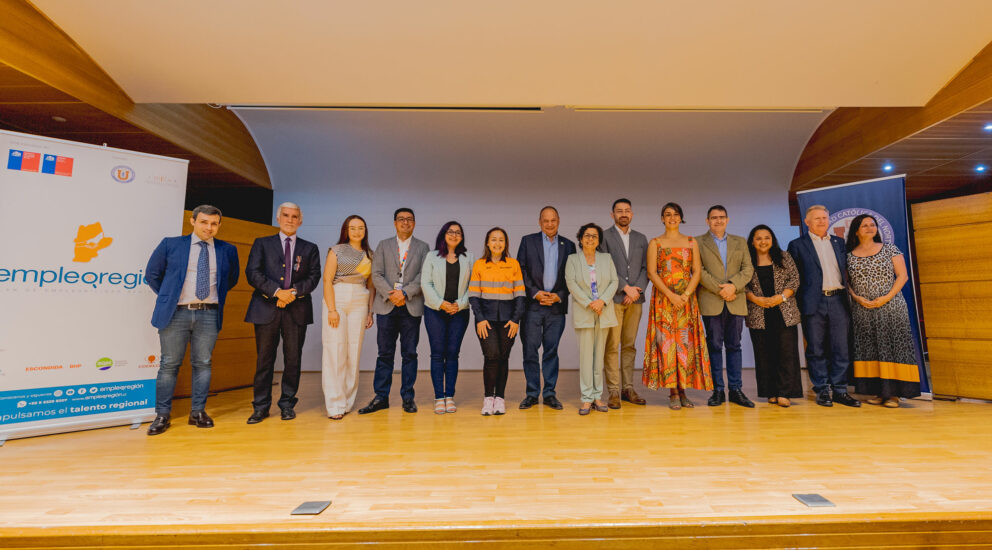
Seminar on Regional Employment Plan addressed the labor market and the impact of interregional commuting
03/Apr/2024
The purpose of this event, organized by the Institute of Applied Regional Economics at Universidad Católica del Norte, IDEAR-UCN, was to launch the second phase of the plan.
The Regional Employment Plan (Plan Empleo-Región) held a seminar open to the Antofagasta community entitled “The importance of local employment to boost regional development,” which addressed the characteristics of the labor market and the impact of interregional commuting.
Participants in the program, organized by the Institute of Applied Regional Economics (IDEAR) at Universidad Católica del Norte (UCN), included the Mining Minister, Aurora Williams; the head of the National Employment Exchange, Sergio Herrera; and the head of the Department of Employment and Training for SENCE Companies, Rodrigo Valdivia; as well as representatives from the university and regional government.
The study developed by IDEAR-UCN was presented during the conference, demonstrating the impact that interregional commuting has on the development of mining regions, with a special focus on the Antofagasta Region. The main result of the study is the substitution effect that the commuting workforce has on the resident workforce, which results in a reduction in wages and a lower employment rate among inhabitants in the areas where commuters are employed.
“Interregional commuting is a phenomenon that particularly affects mining regions, making their labor market different from other regions in the country. Furthermore, we can see that it is bringing in workers with profiles similar to those of resident workers,” said Manuel Pérez, director of the Institute of Applied Regional Economics, IDEAR-UCN.
“If we were to include all the people who commute today, it is approximately four points more than the number of people available in the labor market,” said Mining Minister Aurora Williams. So, this means that commuting indeed has an effect on the regional labor market. Academic studies have also shown that a significant proportion of these commuters do not have the skills or qualifications that the region needs.” She added that “if we manage to implement a program like the Regional Employment Plan, we will be able to make a match between those who live in the region and labor demands. So, in the medium term they can indeed be employed in the region.”
Dr. Rodrigo Sfeir, Vice Rector for Research and Technological Development at UCN, remarked, “It is a pleasure for Universidad Católica del Norte to respond to the challenges we have in the area and to see how we can address them through science and provide solutions to the problems affecting the region. As we begin this second phase, it fills us with pride and satisfaction to see how our capacities, the capacities of our researchers, are serving of our region.”
REGIONAL EMPLOYMENT
The event also featured the launch of the second phase of the Regional Employment Plan, a tool to boost regional development and provide a stronger and more effective connection between labor supply and demand in order to strengthen the employability of the local labor force and improve access to the labor market in the Antofagasta Region.
On another note, Ledys Franco, Regional Employment Coordinator, indicated that since launching in 2022, the Regional Employment portal (www.empleoregion.cl) has more than 39,000 users registered, 478 active companies and a daily average of 350 job vacancies.
“According to the National Employment Survey, between the end of 2022 and the beginning of 2023, more than 5,600 jobs were reported at the regional level. For the same period, the portal offered 4,600 vacancies. If the portal had been the only adjustment mechanism, we would be representing 82% of the total hiring generated in this period,” she commented.
This platform is financed through private resources contributed by SQM, Antofagasta Minerals, BHP, Codelco and Glencore. In this regard, the Corporate Affairs Manager of SQM’s Nitrates Iodine Division, Pablo Pisani said, “We have seen how the work we have done over the last three years has allowed us to build a platform that is useful for the region, providing a very important service not only to match labor supply with labor demand, but also to understand the characteristics of regional employment in order to determine where to develop public policies and private sector initiatives, precisely to strengthen regional employment.”
Likewise, the Mining Minister emphasized that “with the mining companies’ collaboration, we seek to match labor supply with labor demand. This will naturally allow regional employment to grow and it will also reduce pressure on public infrastructure, since the transfer of workers naturally requires infrastructure that makes safe commuting possible.”
During the event, the lines of development for Phase II of the Regional Employment Plan were presented: Portal update, mobile application integration and data management. The UCN Department of Systems and Computer Engineering (DISC) also plays an important role in developing these three lines. “We want to process and analyze the data collected on the platform and mobile application in order to provide unique information to guide the design of public policies aimed at strengthening the regional labor market,” the Regional Employment Coordinator explained.